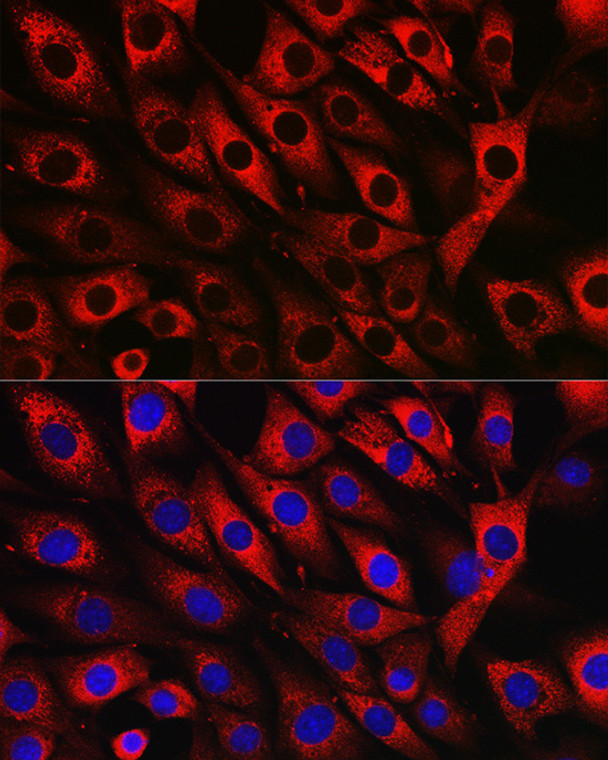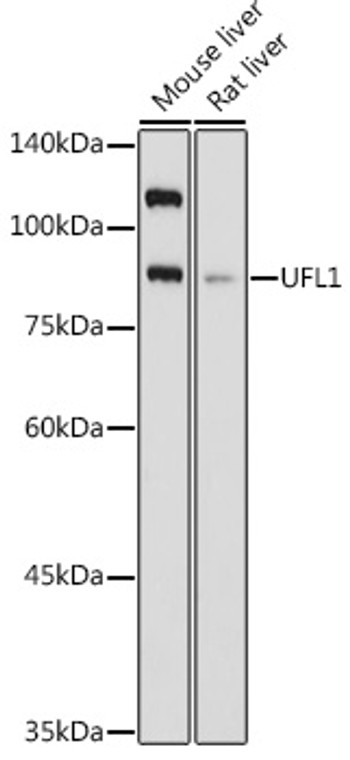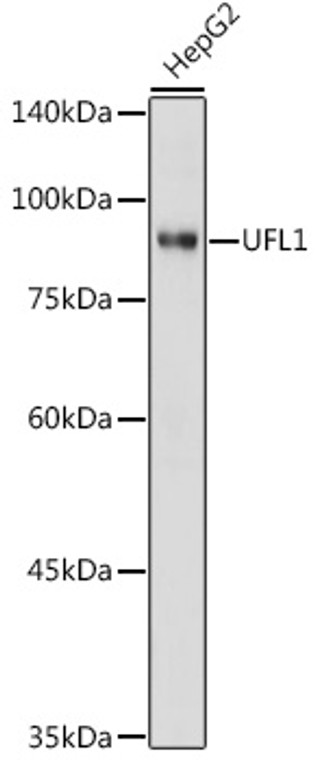| Host: |
Rabbit |
| Applications: |
WB/IF |
| Reactivity: |
Human/Mouse/Rat |
| Note: |
STRICTLY FOR FURTHER SCIENTIFIC RESEARCH USE ONLY (RUO). MUST NOT TO BE USED IN DIAGNOSTIC OR THERAPEUTIC APPLICATIONS. |
| Short Description: |
Rabbit polyclonal antibody anti-UFL1 (601-794) is suitable for use in Western Blot and Immunofluorescence research applications. |
| Clonality: |
Polyclonal |
| Conjugation: |
Unconjugated |
| Isotype: |
IgG |
| Formulation: |
PBS with 0.05% Proclin300, 50% Glycerol, pH7.3. |
| Purification: |
Affinity purification |
| Dilution Range: |
WB 1:500-1:1000IF/ICC 1:50-1:200 |
| Storage Instruction: |
Store at-20°C for up to 1 year from the date of receipt, and avoid repeat freeze-thaw cycles. |
| Gene Symbol: |
UFL1 |
| Gene ID: |
23376 |
| Uniprot ID: |
UFL1_HUMAN |
| Immunogen Region: |
601-794 |
| Immunogen: |
Recombinant fusion protein containing a sequence corresponding to amino acids 601-794 of human UFL1 (NP_056138.1). |
| Immunogen Sequence: |
AAITSEIRKKILSKLSEETK VALTKLHNSLNEKSIEDFIS CLDSAAEACDIMVKRGDKKR ERQILFQHRQALAEQLKVTE DPALILHLTSVLLFQFSTHS MLHAPGRCVPQIIAFLNSKI PEDQHALLVKYQGLVVKQLV SQSKKTGQGDYPLNNELDKE QEDVASTTRKELQELSSSIK DLVLKSRKSSVTEE |
| Tissue Specificity | Ubiquitously expressed, with a high expression in liver (at protein level). Low expression in several invasive hepatocellular carcinomas, such Hep-G2, Hep 3B2.1-7, HLE and PLC. |
| Post Translational Modifications | Ubiquitinated, leading to its degradation by the proteasome. Interaction with CDK5RAP3 protects both proteins against ubiquitination and degradation via the proteasome. Phosphorylated at Ser-462 by ATM, enhancing protein ligase activity and promoting ATM activation in a positive feedback loop. |
| Function | E3 protein ligase that mediates ufmylation, the covalent attachment of the ubiquitin-like modifier UFM1 to lysine residues on target proteins, and which plays a key role in reticulophagy (also called ER-phagy) induced in response to endoplasmic reticulum stress. In response to endoplasmic reticulum stress, recruited to the endoplasmic reticulum membrane by DDRGK1, and mediates ufmylation of proteins such as RPN1 and RPL26/uL24, thereby promoting reticulophagy of endoplasmic reticulum sheets. Ufmylation-dependent reticulophagy inhibits the unfolded protein response (UPR) via ERN1/IRE1-alpha. Ufmylation in response to endoplasmic reticulum stress is essential for processes such as hematopoiesis, blood vessel morphogenesis or inflammatory response. Regulates inflammation in response to endoplasmic reticulum stress by promoting reticulophagy, leading to inhibit the activity of the NF-kappa-B transcription factor. Mediates ufmylation of DDRGK1 and CDK5RAP3.the role of these modifications is however unclear: as both DDRGK1 and CDK5RAP3 act as substrate adapters for ufmylation, it is uncertain whether ufmylation of these proteins is a collateral effect or is required for ufmylation. Catalyzes ufmylation of various subunits of the ribosomal complex or associated components, such as RPS3/uS3, RPS20/uS10, RPL10/uL16, RPL26/uL24 and EIF6. Anchors CDK5RAP3 in the cytoplasm, preventing its translocation to the nucleus which allows expression of the CCND1 cyclin and progression of cells through the G1/S transition. Also involved in the response to DNA damage: recruited to double-strand break sites following DNA damage and mediates monoufmylation of histone H4. Catalyzes ufmylation of TRIP4, thereby playing a role in nuclear receptor-mediated transcription. Required for hematopoietic stem cell function and hematopoiesis. Required for cardiac homeostasis. |
| Protein Name | E3 Ufm1-Protein Ligase 1E3 Ufm1-Protein Transferase 1Multiple Alpha-Helix Protein Located At ErNovel Lzap-Binding ProteinRegulator Of C53/Lzap And Ddrgk1 |
| Database Links | Reactome: R-HSA-983168 |
| Cellular Localisation | Endoplasmic Reticulum MembraneCytoplasmCytosolNucleusChromosomeRecruited To Double-Strand Breaks By The Mre11-Rad50-Nbn (Mrn) Complex Following Dna Damage |
| Alternative Antibody Names | Anti-E3 Ufm1-Protein Ligase 1 antibodyAnti-E3 Ufm1-Protein Transferase 1 antibodyAnti-Multiple Alpha-Helix Protein Located At Er antibodyAnti-Novel Lzap-Binding Protein antibodyAnti-Regulator Of C53/Lzap And Ddrgk1 antibodyAnti-UFL1 antibodyAnti-KIAA0776 antibodyAnti-MAXER antibodyAnti-NLBP antibodyAnti-RCAD antibody |
Information sourced from Uniprot.org
12 months for antibodies. 6 months for ELISA Kits. Please see website T&Cs for further guidance








